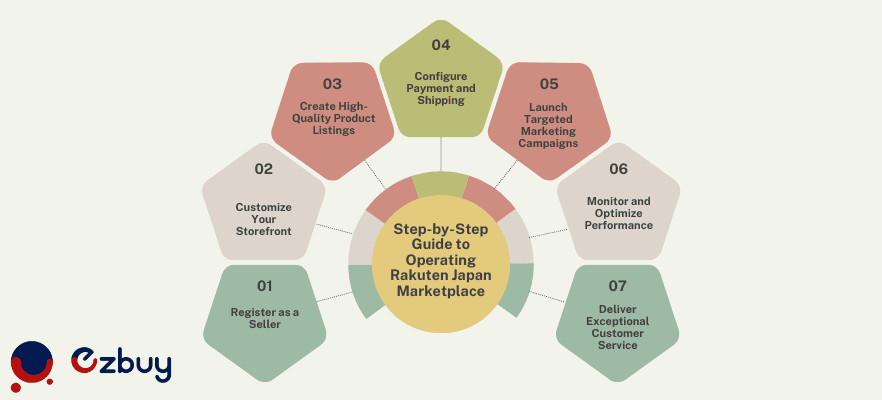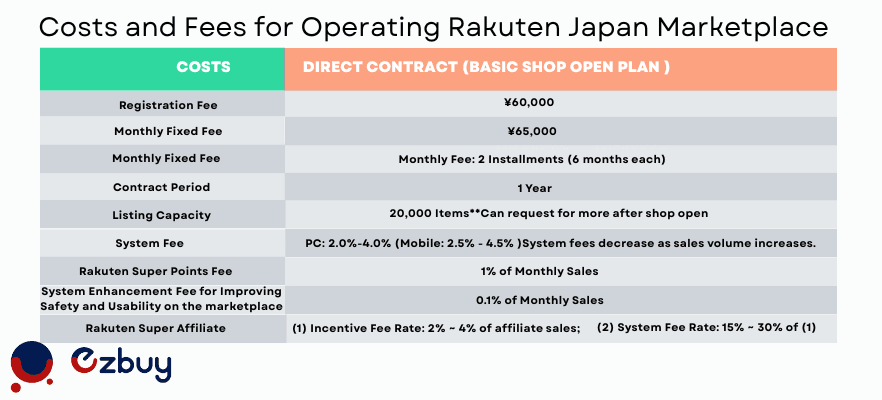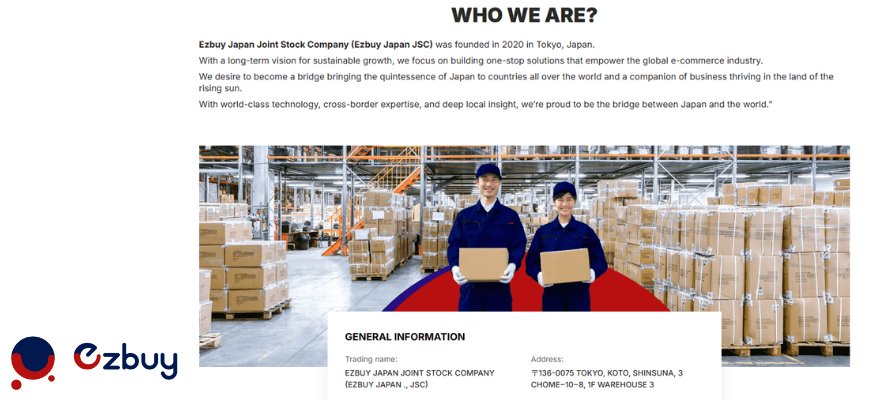Operating Rakuten Japan Marketplace: Costs, Steps, and Tips for Sellers
By Macy -26/06/2025 UTC.
Operating Rakuten Japan Marketplace unlocks a gateway to one of the world’s most lucrative eCommerce markets, with over 100 million registered users and a reputation for trust, innovation, and customer loyalty. As Japan’s leading online marketplace, Rakuten combines a vast audience with a unique points-based loyalty system, making it a prime platform for international sellers seeking global expansion. However, successfully operating Rakuten Japan Marketplace demands navigating specific costs, cultural nuances, and logistical complexities.
This comprehensive guide, optimized for the keyword Operating Rakuten Japan Marketplace, details the benefits, prerequisites, step-by-step setup process, top product categories, costs, challenges, and expert tips for sellers. Additionally, we’ll explore why partnering with Ezbuy Japan, a premier eCommerce enabler, can streamline cross-border logistics and fulfillment, empowering sellers to thrive in this competitive ecosystem.

1. Benefits of Operating a Store on Rakuten Japan Marketplace
Operating Rakuten Japan Marketplace offers compelling advantages that set it apart:
- Vast customer reach: With over 100 million registered users, Rakuten provides access to Japan’s affluent and tech-savvy consumer base.
- Customizable storefronts: Unlike Amazon’s standardized listings, Rakuten allows sellers to design unique shop layouts, banners, and product pages, enhancing brand identity and customer trust.
- Rakuten points system: This loyalty program incentivizes frequent shopping by awarding points on purchases, redeemable for future transactions, boosting customer retention.
- Localized yet global: Rakuten blends deep cultural insights with a global infrastructure, ideal for international sellers targeting Japanese consumers.
- Robust marketing tools: Sellers can leverage email campaigns, sponsored listings, banner ads, and Super Points promotions to enhance visibility.
- Cross-border opportunities: International sellers can dropship directly from overseas warehouses without a Japanese entity, making market entry accessible.
- Data-driven iInsights: The Rakuten Merchant Server (RMS) provides analytics on sales, traffic, and customer behavior, enabling informed decision-making.
These benefits make operating Rakuten Japan Marketplace a strategic choice for sellers aiming to grow in Asia’s second-largest eCommerce market.
2. Prerequisites for International Sellers
To successfully operate on Rakuten Japan Marketplace, international sellers must meet several requirements:
- Business registration: Your business must be a registered corporation, not a sole proprietorship. Rakuten requires a good credit file, such as a Creditsafe report or Dun & Bradstreet D-U-N-S number.
- Bank account for payments: Sellers need a bank account capable of receiving Japanese Yen (JPY). A Japanese bank account is preferred, but payment gateways like Payoneer or Wise are viable alternatives.
- Japanese language proficiency: All product listings, customer service, and marketing materials must be in fluent, native-level Japanese. Professional translation services or localization agencies are essential for accuracy and cultural relevance.
- Reliable logistics partner: Efficient fulfillment is critical to meet Japan’s high standards for fast delivery. Partnering with Ezbuy Japan ensures seamless shipping, customs clearance, and returns management.
- Tax compliance: Sellers with annual sales exceeding ¥10 million in Japan must register for Japan Consumption Tax (JCT, 10%). Consulting a tax professional is advisable.
- Understanding Rakuten’s policies: Familiarize yourself with Rakuten’s seller guidelines, including prohibited items, listing standards, and customer service expectations, to avoid penalties.
Meeting these prerequisites ensures a smooth onboarding process for operating Rakuten Japan Marketplace.
3. Step-by-Step Guide to Operating Rakuten Japan Marketplace

Launching and managing a Rakuten Japan store involves a structured process. Follow these steps:
Register as a Seller:
- Visit the Rakuten Ichiba seller portal or Rakuten Global Market website to begin registration.
- Submit business registration, tax ID, and bank account details.
- Await approval, which typically takes 1-2 weeks, depending on documentation.
Customize your storefront:
- Use Rakuten Merchant Server (RMS) platform to design a professional storefront with a logo, banner, and store description in Japanese.
- Align with Japanese aesthetic preferences, such as clean, minimalist designs, and optimize for mobile, as over 70% of traffic comes from smartphones.
Create high-quality product listings:
- Develop detailed listings with high-resolution images (minimum 1000x1000 pixels), accurate descriptions, and competitive pricing.
- Incorporate Japanese keywords to improve search visibility within Rakuten’s internal search engine.
- Specify shipping options, delivery timelines, and return policies to build trust.
Configure payment and shipping:
- Integrate popular payment methods, including credit cards, Rakuten Pay, bank transfers, and cash-on-delivery (COD), widely used in Japan.
- Partner with Ezbuy Japan for efficient cross-border logistics, including warehousing, customs clearance, and last-mile delivery.
Launch targeted marketing campaigns:
- Utilize Rakuten’s advertising tools, such as Super Points campaigns, sponsored listings, or banner ads, to drive traffic.
- Optimize listings with relevant keywords to rank higher in Rakuten’s search results.
- Promote your store on Japanese social platforms like LINE, X, or Instagram, using hashtags like #RakutenJapan or #EcommerceJapan.
Monitor and optimize performance:
- Leverage RMS analytics to track sales, traffic sources, conversion rates, and customer demographics.
- Adjust pricing, inventory, or promotions based on data insights.
- Conduct A/B testing on product titles or images to identify high-performing variations.
Deliver exceptional customer service:
- Respond to customer inquiries in Japanese within 24 hours to meet Rakuten’s standards.
- Streamline returns and refunds to maintain a positive reputation.
- Use automated tools or bilingual staff for efficient communication.
- These steps provide a roadmap for successfully operating Rakuten Japan Marketplace.
>>> Read more: How to Sell on Rakuten Marketplace: A Complete 2025 Guide
4. Top Product Categories for Success on Rakuten Japan
Certain product categories thrive on Rakuten Japan due to consumer demand and cultural preferences:
- Fashion and Accessories: Trendy clothing, luxury bags, and kawaii accessories appeal to Japan’s fashion-conscious shoppers, especially younger demographics.
- Beauty and Cosmetics: Organic skincare, K-beauty, and J-beauty products are in high demand, driven by a focus on quality and innovation.
- Electronics and Gadgets: Smartphones, gaming accessories, and innovative tech resonate with Japan’s tech-savvy population.
- Health and Wellness: Supplements, eco-friendly fitness gear, and wellness products are gaining traction as consumers prioritize self-care.
- Food and Beverages: Specialty snacks, organic foods, and international delicacies attract gourmet shoppers and gift-givers.
- Home and Living: Minimalist decor, smart appliances, and space-saving storage solutions align with Japan’s urban lifestyle.
Sellers can use Google Trends, Rakuten Category Insights, or Ahrefs to identify trending products and seasonal opportunities, such as gift items for Obon or New Year.
5. Costs and Fees for Operating Rakuten Japan Marketplace

Operating on Rakuten involves several costs, which vary based on your plan and sales volume:
- Monthly store fee: Ranges from ¥19,500 to ¥100,000 ($130-$670 USD), depending on the plan (e.g., Standard, Mega Shop). Premium plans include advanced analytics and marketing features.
- Commission fees: Rakuten charges 8-20% per sale, varying by category (e.g., 8-10% for electronics, 15-20% for fashion).
- Transaction fees: Payment processing fees for credit cards, Rakuten Pay, or COD range from 2.5-4% per transaction.
- Advertising costs: Optional campaigns like Super Points or banner ads start at ¥10,000, scaling with reach and duration.
- Logistics and fulfillment: Shipping costs depend on product weight and destination. International sellers face customs duties and import taxes, which Ezbuy Japan can optimize.
- Localization and translation: Professional translation costs $0.05-$0.15 per word for listings and support. Ongoing customer service may require bilingual staff or outsourcing.
- Miscellaneous costs: Product photography, graphic design, or compliance testing (e.g., for electronics or cosmetics) may incur additional fees.
To maximize profitability, focus on high-margin products and negotiate shipping rates when operating Rakuten Japan Marketplace.
6. Challenges and Tips for Success in Operating Rakuten Japan Marketplace
Challenges
- Language and Cultural Barriers: Non-Japanese speakers may struggle with localization and cultural expectations.
- High Competition: With over 49,000 merchants, standing out requires competitive pricing and strong branding.
- Logistics Complexity: Cross-border shipping, customs, and returns can be challenging without a reliable partner.
- Consumer Expectations: Japanese shoppers demand fast delivery (1-2 days), high-quality products, and responsive support.
- Fee Structure: High commissions and fees can impact low-margin products.
Tips for Success
- Invest in Localization: Hire native Japanese translators for accurate, culturally relevant listings and support.
- Leverage RMS Analytics: Optimize products and pricing based on sales and traffic data.
- Prioritize Customer Experience: Offer fast shipping, clear return policies, and 24/7 support.
- Differentiate Offerings: Highlight unique features, eco-friendly materials, or exclusive promotions.
- Partner with Ezbuy Japan: Streamline logistics, reduce costs, and ensure compliance.
- Capitalize on Seasonal Trends: Stock products for holidays like Golden Week, Obon, or New Year, and join Rakuten’s Super Sale events.
- Incorporate Social Proof: Display customer reviews to build credibility, as Japanese consumers value peer feedback.
- Optimize for Voice Search: Use conversational keywords (e.g., “Where to buy organic skincare in Japan?”) to capture voice search traffic.
These strategies help overcome challenges when operating the Rakuten Japan Marketplace.
7. Why Choose Ezbuy Japan as Your Rakuten Logistics Partner?

Ezbuy Japan is a leading eCommerce enabler specializing in cross-border logistics and fulfillment, making it an ideal partner for sellers operating Rakuten Japan Marketplace. Their comprehensive services are designed to simplify the complexities of selling in Japan, ensuring seamless operations and enhanced profitability.
With a strategically located warehouse fulfillment center at 〒136-0075 Tokyo, Koto, Shinsuna, 3 Chome−10−8, 1F Warehouse 3, Ezbuy offers significant advantages for sellers, ensuring fast domestic delivery.
Key benefits include:
- End-to-End fulfillment: Ezbuy Japan manages the entire logistics chain, from warehousing and inventory management to last-mile delivery. Their state-of-the-art facilities ensure accurate order processing, timely shipping, and efficient returns handling, meeting Japan’s high customer expectations.
- AI-Powered technology: Leveraging advanced artificial intelligence, Ezbuy Japan optimizes shipping routes, predicts inventory demand, and reduces operational costs. Their platform provides real-time tracking and analytics, enabling sellers to make data-driven decisions and improve efficiency.
- Customs and compliance expertise: Navigating Japan’s complex import regulations can be daunting, but Ezbuy Japan excels in customs clearance and compliance. They ensure products meet standards like the Product Liability Act or Food Sanitation Law, minimizing delays and penalties.
- Scalable solutions: Whether you’re a small startup or a large enterprise, Ezbuy Japan tailors its services to your needs. Their flexible solutions support businesses at every growth stage, from initial market entry to large-scale operations.
- Cost efficiency: Ezbuy Japan’s extensive logistics network and strategic partnerships enable competitive shipping rates and reduced fulfillment costs. By minimizing customs duties and optimizing delivery processes, they help sellers maximize profit margins.
- Customer-centric approach: Prioritizing reliability, transparency, and fast delivery, Ezbuy Japan enhances the buyer experience, which is critical for maintaining a positive reputation on Rakuten. Their dedicated support team ensures prompt resolution of any issues.
- Seamless integration: Ezbuy Japan integrates with Rakuten’s platform, enabling automated order syncing and inventory updates. This reduces manual work and ensures real-time accuracy across sales channels.
By partnering with Ezbuy Japan, sellers can focus on scaling their business—optimizing product listings, running marketing campaigns, and expanding their catalog—while leaving logistics to experts. Their tailored solutions not only streamline operations but also enhance competitiveness in Japan’s fast-paced eCommerce landscape. Contact Ezbuy Japan today to explore how their services can elevate your Rakuten Japan operations and drive long-term success.
8. Advanced Strategies for Rakuten Japan Success
To further enhance success when operating Rakuten Japan Marketplace, consider these strategies:
- Video Content: Create product demos or testimonials for listings and promote on YouTube or X with keywords like “製品レビュー” (product review).
- Rakuten Events: Join Super Sale or Shopping Marathon with discounts or bonus Rakuten Points to attract shoppers.
- Competitor Analysis: Use SEMrush or Jungle Scout to monitor competitors’ pricing and keyword strategies.
- Social Media Engagement: Build a presence on LINE or X with hashtags like #RakutenJapan or #JapanShopping.
- Sustainability Appeal: Promote eco-friendly products like “ゼロウェイスト商品” (zero-waste) to align with market trends.
- Bundling Products: Offer gift sets, especially during holidays, to increase average order value.
These strategies, combined with Ezbuy Japan’s logistics support, can significantly boost your store’s performance.
>>> Read more: Operating Amazon Japan Marketplace – Ultimate Guide For Sellers
9. FAQ
- Is a Japanese bank account required for operating Rakuten Japan Marketplace?
No, but it’s preferred. Payoneer or Wise can handle JPY payments. - How long does it take to launch a Rakuten Japan store?
Approval takes 1-2 weeks, plus 1-2 weeks for setup and logistics. - What payment methods are popular on Rakuten Japan?
Credit cards, Rakuten Pay, bank transfers, and cash-on-delivery. - Can I sell international products on Rakuten Japan?
Yes, if compliant with regulations. Ezbuy Japan assists with logistics. - How to compete with established sellers?
Focus on niche products, optimize keywords, and use Rakuten’s advertising tools.
10. Conclusion
Operating Rakuten Japan Marketplace offers international sellers access to a dynamic market with millions of loyal customers and a trusted platform. Success requires meeting prerequisites, managing costs, and overcoming challenges like localization and logistics. By leveraging Rakuten’s tools, optimizing listings with Japanese keywords, capitalizing on seasonal trends, and delivering exceptional service, sellers can unlock the platform’s potential.
Partnering with Ezbuy Japan streamlines cross-border fulfillment, reduces costs, and ensures compliance, making it easier to thrive when operating Rakuten Japan Marketplace. Start your Rakuten Japan journey today and tap into the immense opportunities of Japan’s eCommerce ecosystem!